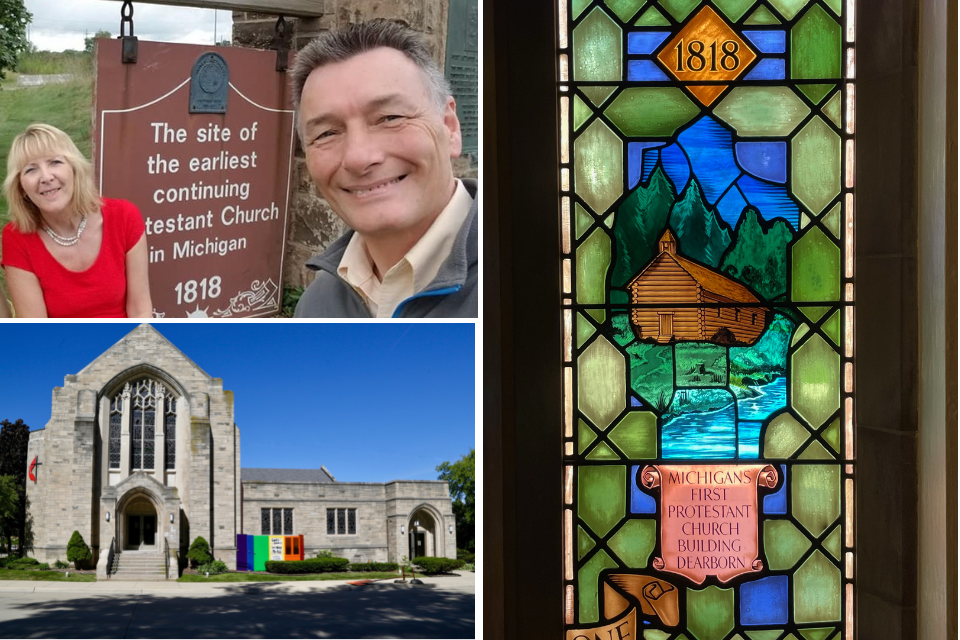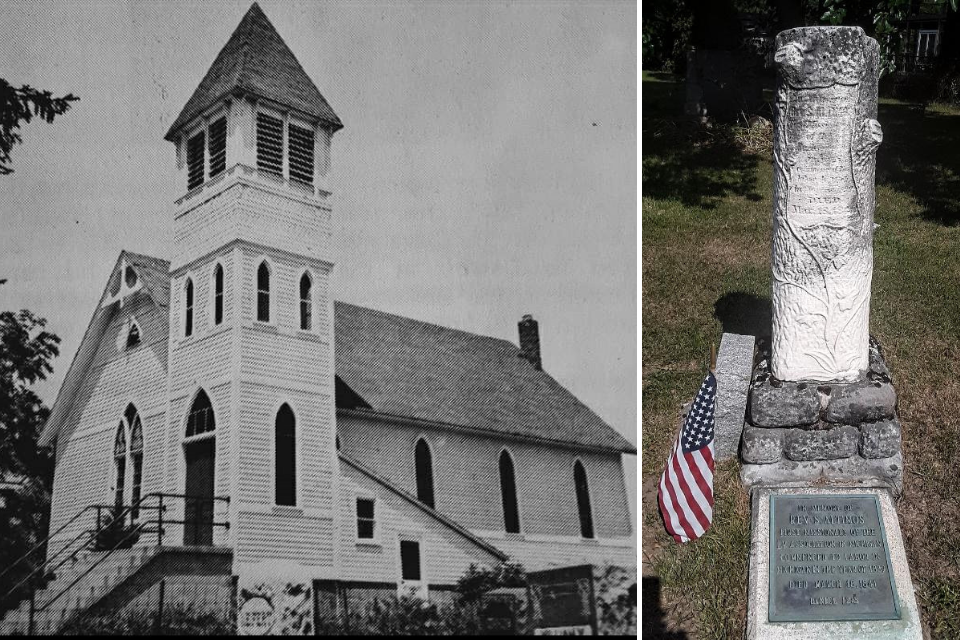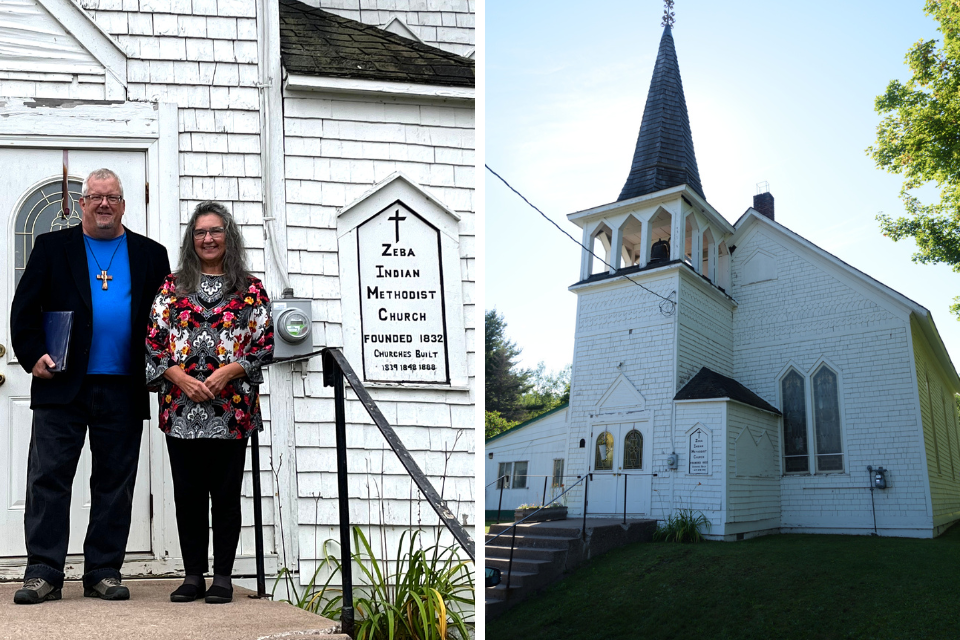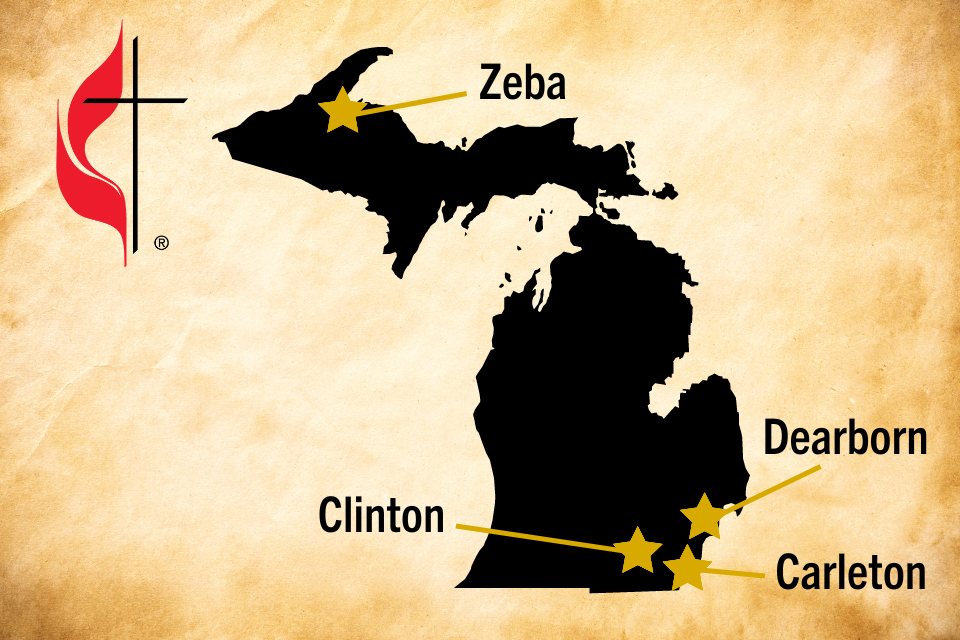Take a trip through the Lower and Upper Peninsulas, visiting four places and learning about the people that have made them important to Michigan United Methodist history.
GLENN M. WAGNER
Michigan Conference Communications
When facing present challenges or preparing for the future, remembering Christian role models from our past, the places they served, and the lessons they teach through current witnesses often inspire us.
This guide will take you to historical places in Michigan with a key Methodist connection and introduce you to early witnesses for the gospel who have helped shape our denomination’s current ministry for Christ. Along the way, you will also hear from Michiganders today who relate how these historical places and people continue to inspire faith.
This second of two articles on Michigan Methodist history (click this link to read the first article) features the following places and people: (1) the original Methodist Log Church near Dearborn and its successor congregations and ministries, (2) the sacrificial leadership of Solomon Altimos, who was credited with the birth of the Evangelical Church in Michigan and the Port Creek Evangelical Church near Carleton, (3) the story of the Clinton United Methodist Church as told by two of its current members and how the oldest surviving Methodist church building in Michigan became an independent Romanian Orthodox Monastery, and (4) the important ministry of Methodist pastor and Ojibway chief Peter Marksman and the Zeba Indian United Methodist Church in the Upper Peninsula as remembered by current pastor Mark A. Miller and Marksman’s great-great-granddaughter Susan LaFernier.
Site of Original Log Church near Dearborn
Driving directions: Our road trip through Michigan Methodist history begins at the historical marker remembering the original Methodist Log Church at the River Rouge near Dearborn. Travel to eastern Michigan via I-94 to Dearborn, exit at Greenfield Road, and head south to Butler Road. The marker is 0.2 mile east on Butler, on the north side of the road.
Dearborn is a city in Wayne County near Detroit with a population in 2020 of 109,976, making it the seventh largest city in Michigan. Today, Dearborn is home to the largest Muslim population per capita in the United States and this nation’s largest mosque. Dearborn is the location of the Ford Motor Company’s world headquarters. Dearborn is also where the history of Methodism in this state began in 1810, predating the founding of Michigan by nearly 27 years.
The first Methodists gathered for worship in 1810 near property now occupied by the Ford Motor Company’s River Rouge plant. Rev. William Mitchell organized the first Methodist Society in Michigan, consisting of seven members: William and Maria McCarty, Robert and Betsey Abbott, William and Betsey Stacy, and Mrs. Sarah Macomb, who formed the westernmost congregation of the Upper Canada District of the Genesee Conference (now the Upper New York Conference).
In the spring of 1818, these earliest Michigan Methodists, under the leadership of Thomas Harmon, a local preacher from Canada who had fought against the Americans in the War of 1812, proceeded to build a log church on one acre of land along the banks of the River Rouge deeded by Thomas and Margarette Sargent. An early map located the property just west of the Dearborn town line, on Dearborn Road running on the north side of the river.

A picture published in 1878 shows this log church building near the river with a crude bark canoe lying on the nearby bank, suggesting that this was a prominent method of traveling to the church. Some early worshipers certainly walked to church; others rode on horseback. They might have also come by wagon or cart. A 2013 tour guide published by the Dearborn Historical Commission notes, “The Methodists were the first Protestant body to organize a congregation and erect a church building in Michigan.”
By 1830 the ministry at the log church ended as the building fell into disrepair and eventually burned. In June 1851, Methodist leaders in Detroit visited this historic site, salvaged the remaining timbers, and had about 30 canes fashioned from the reclaimed wood. One of those canes belonging to Rev. Elijah Pilcher became the Detroit Conference cane, which has been passed down through the oldest surviving clergy in the conference. Today, this cane is permanently kept in the Michigan Conference Archives at Adrian College, and the “holder” of the cane receives recognition for the honor. Methodists from this original log church went on to found Dearborn First United Methodist Church and Central United Methodist Church in Detroit (located across from Comerica Park), Michigan’s two oldest United Methodist congregations. In 1838 the remaining Methodists in Dearborn built a more permanent structure on Park Street.
From 1893-1923, Dearborn Methodists occupied a new building named the Ten Eyck Memorial Methodist Episcopal Church, which was located on the north side of Michigan Avenue, between Mason and Howard Streets, in Dearborn, where Buddy’s Pizza now stands.
The current site of Dearborn First UMC is located on Garrison Street between Mason and Howard Streets. This building was dedicated in 1926. Since then, additional wings have been added to accommodate Sunday school rooms and meeting spaces.
Rev. David Nellist, pastor of Dearborn First UMC, is proud of his congregation’s history. He also affirms that current church ministries focus on living out the mission of Christ to meet the present and future needs of their community. Established programs address the current climate crisis and environmental justice. Dearborn First partners in volunteer service with organizations such as Cass Community Social Services and the Dearborn Toy Library. Members of the church form a Response Team working to meet the needs of neighbors and immigrants. The church is proud to be a reconciling congregation and the flagship Metro Detroit site for Justice for Our Neighbors-Michigan (JFON-MI). Nellist explains, “JFON is a faith-driven hospitality ministry, welcoming immigrants into our churches and communities by providing free, high-quality immigration legal services, education, and advocacy.”
Travel tip: According to Dearborn First’s pastor, David Nellist, visitors to Dearborn who come for the history may also wish to stop for a meal at Buddy’s Pizza on the former site of the third Methodist church building at 22148 Michigan Avenue.
Evangelical Church Origins at Port Creek near Carlton
Driving directions: Click this link for driving directions from the site of the Dearborn log church to the grave of Solomon Altimos, founder of the Evangelical church in Michigan, in the Port Creek Evergreen Cemetery in Carleton, and the site of the former Port Creek Evangelical Church, Michigan’s first Evangelical congregation, 14428 Port Creek Road. Please note that the church building is now a private residence. Driving time is 26 minutes.
A significant part of Michigan United Methodist history can be traced back to 1838 and the early witness of Christians affiliated with the Evangelical denomination. The Evangelical and United Brethren denominations later merged in 1946 to become the Evangelical United Brethren (EUB) Church. The EUB denomination then combined with the Methodist Episcopal Church in 1968 to form The United Methodist Church. Both the Evangelical and United Brethren churches were similar to Methodism in structure, history, and beliefs. At the time of the 1968 merger, the Michigan Conference of the Evangelical United Brethren Church contained 123 congregations served by 107 ordained elders and connected with 25 students preparing for ministry. Many former EUB congregations have combined since the merger with existing Methodist churches.
According to Rebecca McNitt, Michigan Conference Archivist at Adrian College, 42 United Methodist congregations in Michigan still maintain their strong EUB heritage. McNitt defines these churches as those that either have not merged with a previously Methodist congregation since 1968 or have only merged with other formerly EUB churches.
The first Evangelical ministry in Michigan dates to a Watch Night service on Christmas Eve in 1838 along Port Creek, a stream in Monroe County about 6 miles northeast of Carleton, MI. The service was led by Solomon Altimos, licensed in 1833 as a preacher by the East Pennsylvania Conference of the Evangelical Church.
Altimos is also credited with earlier helping to start an Evangelical church in Allentown, PA, despite experiencing persecution for his efforts. Chronic epileptic seizures forced Altimos to take medical leave from his Pennsylvania ministry. Still, his ailments did not deter his calling to serve Christ. Altimos migrated some 500 miles west from Pennsylvania to Ash Township, MI, and was inspired to hold a Christmas Eve worship with fellow immigrants to the area. He held his second service in Michigan six days later on December 31, 1838, near Swan Creek, 8 miles northwest of Carleton. The following week, on January 5, 1839, Altimos visited Detroit and preached three times in German.

With a passion to share the gospel, Altimos returned to Pennsylvania to recruit more workers for Christ to serve the growing number of newcomers to Michigan. Altimos then traveled back to Michigan to continue his ministry at Port Creek. He was stricken with another severe attack of epilepsy while preaching and died days later on Thursday, March 18, 1841, in a friend’s home.
The Port Creek Evangelical Church was built in 1893 next to the Port Creek Evergreen Cemetery, where the grave of Solomon Altimos remains an important testament to his sacrificial and pioneering ministry in Michigan.
The Port Creek Evangelical and United Brethren Church merged with the Carleton United Methodist Church in 1968 as a part of the historic denominational merger between the Methodists and the EUB. The church building was sold and has since been remade into a private family residence that still stands next to the cemetery where Solomon Altimos is buried.
Jim Pershing is an active volunteer for the Carleton Historical Society Museum. The free museum is open on the first and third Saturdays of each month from 9 am to 1 pm or by appointment. Pershing and the museum are valuable sources for history about the Port Creek Evangelical Church. The museum is located at 1677 Ready Road in Carleton, 4.7 miles southwest of the Altimos grave and former church site.
Travel tip: Carleton Historical Society volunteer Jim Pershing recommends that those coming to view the Port Creek site and the grave of Solomon Altimos should consider eating at the Farmer’s Café, located at 141 Medical Center Drive just off Grafton Road in Carleton.
Oldest Surviving Methodist Church in Clinton
Driving directions: Click this link for driving directions from Carleton to Clinton, to learn about the history of Clinton United Methodist Church and the story of what was the oldest surviving Methodist church building in Michigan. Driving time is 52 minutes.
Roger Waltz has lived every one of his 87 years as a member of the historic Clinton United Methodist Church. He was baptized as an infant at the church by Rev. Rial Simmons. Waltz regularly worshiped in the original church building that, from its construction in 1837 until it was sold in 2000, was the oldest Methodist building still in use in Michigan. In 2000, a new home for the congregation was constructed 1.75 miles south on Tecumseh-Clinton Highway.
Waltz, a faithful member of the bass section of the Clinton United Methodist Church choir, was also head of the Board of Trustees when the church decided to sell their historic building to the Solid Rock Church. Waltz remembers the factors which spurred the congregation to move and begin a new chapter. Their landmark church building was inaccessible to persons with mobility issues. It was landlocked on a small parcel without adequate parking, and neighbors were unwilling to sell additional property to the congregation. The locally made bricks which formed three-foot thick exterior walls made extensive remodeling impractical.
A generous financial grant from an area foundation pledged to match church contributions, and the Clinton United Methodist congregation was able to raise funds necessary to procure and build on a larger 8-acre parcel at 10990 Tecumseh-Clinton Highway. This parcel was once part of a potato farm owned by the C.J. Kuehmann Potato Chip Company from Toledo, OH. This newer church building is 1.7 miles south of the original church building that still stands at 112 E. Church Street in Clinton.
According to the Michigan Conference Archives, the Clinton Methodist congregation traces its beginning to the fall of 1826: “The Ohio Conference increased its appointments in Michigan from two to four, adding the Monroe Circuit and St. Clair Mission to the Detroit Circuit and Detroit City. The previous year John A. Baughman had served the Detroit Circuit preaching as far west as Ypsilanti and Ann Arbor. Now he was appointed to the new Monroe Circuit, which proved to be a very difficult one. The flat country back from Lake Erie in Monroe County, southern Wayne County, and northern Ohio was very swampy and wet in its wilderness state and travel was arduous. Baughman at once established Tecumseh, and almost certainly Clinton, as preaching points on the circuit. [Famed preacher] Elijah Pilcher, on the Tecumseh Circuit, in 1831-32, preached at both Clinton and Tecumseh every fourth Sunday; with the junior preacher, these adjoining towns had preaching services every other Sunday.
“In the autumn of 1828, Rev. Joseph Bangs, a local preacher and brother of the prominent Methodist leader Rev. Nathan Bangs, moved to the area and settled on the Raisin River between Clinton and Tecumseh. His coming greatly strengthened the cause of Methodism in the area. He worked as a blacksmith and farmer, and did a great deal of preaching. . . . The Methodists in Clinton and Tecumseh were closely linked together in the early years.”
The Clinton Society bought land from the government in 1835. Instead of building a suitable frame structure out of wood, which would have been simpler and cheaper, they decided to build “at great expense, labor, and sacrifice, a brick church,” according to a historian. The edifice was started in 1837. The bricks were made locally. The walls of the church were made 3 feet thick, and the timbers were hand-hewn oak. The new church was costly, with a large mortgage, and the Clinton Methodists were in danger of losing their church. “Some of the builders mortgaged their own farms, to save the church,” the history states.

Waltz recalls that the earliest residents of Clinton were the Ojibway (Chippewa), whose settlement along the River Raisin was called Oak Openings. The new community grew up surrounded by farms with early settlers migrating from New York, who renamed their town Clinton in honor of DeWitt Clinton (1769-1828). Clinton had served in New York as mayor of New York City, U.S. senator, and governor. While governor, he was responsible for the building of the Erie Canal. He also ran in 1812 for the presidency of the United States as the candidate for the Federalist Party but was defeated by James Madison in the general election.
Waltz further noted an important chapter in Clinton history in the late 1940s when Don Thomas began the Clinton Machine Company, which manufactured tank turret gears during World War II. The company became so successful that he ran out of space in Detroit and moved to Clinton.
After the war, Thomas predicted demand for small engines, such as those for lawnmowers, would be high and began manufacturing them. The company employed 1,000 workers by the end of 1946. In 1950, Thomas further expanded the company and relocated to Iowa.
Waltz acknowledges that Clinton is now primarily a bedroom community, with many of the town’s 2,900 residents commuting for work to places like Ann Arbor, Ypsilanti, or Adrian.
Waltz notes that the Clinton United Methodist Church has benefited from its new location. A larger space for a kitchen has allowed the congregation to strengthen the community with shared meals. The parking lot has proven vital, especially during the recent pandemic when services were broadcast over FM radio from the church into the parking lot, thanks to member Rick Grzebik, a broadcast engineer. Grzebik noted that the drive-in church was so successful that offerings to the church increased during the pandemic.
Grzebik remembers that the Solid Rock Church that purchased the original Methodist building later relocated to the former Ford dealership building in Clinton. The original building has since been sold again to an independent Romanian Orthodox community. It is currently being used as a monastery that also offers Romanian Orthodox services each Sunday.
Travel tip: Clinton UMC member Rick Grzebik adds that persons who visit Clinton to view the Orthodox monastery (formerly the original Methodist building) and the new Clinton United Methodist Church with the marker remembering the history may enjoy the popular Clinton Coney Island restaurant nearby that features an excellent variety for breakfast and lunch.
Zeba Indian Church and the Legacy of Peter Marksman
Driving directions: Click this link for driving directions from Clinton to Zeba, to learn about the ministry of Methodist pastor and Ojibway chief Peter Marksman and the historic Zeba Indian United Methodist Church in the Upper Peninsula. Driving time is 8 hours, 16 minutes.
Travel to the eastern side of the Keweenaw Bay in Michigan’s Upper Peninsula, and you will learn that Methodists have been in ministry with the Ojibway in Zeba for 190 years.
The Michigan Conference Archives remembers the beginnings of the Zeba ministry: “In 1832 John Sunday, the Chippewa Methodist Indian missionary from Canada, came from the Soo to Kewawenon, an Indian settlement north of present-day L’Anse, and spent the fall and winter. He began educational work with two small girls. Soon he had 15 scholars, and taught them the Lord’s Prayer, the Apostles’ Creed, and the Decalogue in Chippewa. Curiosity conquered prejudice and finally adults came to hear him. Soon a medicine man accepted Christianity.”
When Rev. John Clark visited the area two years later, he baptized 15 and administered the Lord’s Supper to about 40. There Clark gave direction and permanence to the work by the erection of a log mission house, a schoolhouse, and cabins along the shore of Keweenaw Bay.
In the fall of 1837, the Michigan Conference appointed D.M. Chandler to Sault Ste. Marie and Keweenaw. He was a sacrificial missionary. He dared to make the 235-mile trip from the Soo west to Keweenaw on snowshoes in the dead of winter. Early the following spring, he returned to the Soo by canoe through Lake Superior, where his family had been enduring hardship.
This Methodist ministry with Native Americans in the northwestern section of Michigan’s Upper Peninsula predated the 1854 Chippewa Treaty that established the L’Anse Indian Reservation, approximately 100 square miles of Native American land in two contiguous areas wrapping around both sides of Keweenaw Bay. It is the largest reservation in Michigan.
Zeba Indian United Methodist Church, an important part of this reservation, is situated near the bay’s eastern shore. The present white wood-framed church building with a steeple was erected in 1888. The original congregation first met in a log mission house erected in 1834 and later in a larger church dedicated on June 19, 1850.

Another early leader of the Zeba Indian United Methodist Church was Peter Marksman. Marksman, who lived from 1817-92, was a Methodist minister who was a member of the L’Anse Band of Lake Superior Chippewa. His native name was Ma-dwa-gwun-a-yaush, from the Ojibway meaning “Arrow-Feathers Are Heard in the Breeze,” which indicates his reputation as an expert archer/marksman. He chose Marksman as his surname when he converted to Christianity in the log schoolhouse of the Soo Indian Mission near Sault Ste. Marie, under the preaching of Rev. John Clark about 1833.
Peter Marksman became an effective minister. At one time, he preached on the parable of the prodigal son, and those listening were moved to tears. One history of Methodism in the Upper Peninsula noted him saying these words: “Men, women, and children rose up, saying, ‘We will arise up and embrace Christianity.’ Monday morning they all brought their images and bad medicines to me. I took them all and did burn and destroy them before their eyes.’”
The history continued: “He often knew severe exposure and hardship. In person he was scrupulously neat . . . dignified and graceful in manner. In his prime he was eloquent as a preacher.” As a chief, he was a signatory to the 1847 Treaty of Fond du Lac and the 1854 Treaty of La Pointe. His wife’s name was Hannah. The Hannahville Indian Community, located 15 miles west of Escanaba, MI, chose to be named after her in honor of Marksman and his wife. The history concluded, “This shining light of early Methodism among the Indians of the Upper Peninsula died at L’Anse, March 28, 1802, aged about 75.”
Susan LaFernier, Marksman’s great-great-granddaughter, is still an active member of the church and the tribal community at Zeba. She is vice president of the tribal council and works in accounting for Keweenaw Bay Indian Community. Susan participated in a high school project to correspond with soldiers from the Upper Peninsula serving in Vietnam. When Michael LaFernier returned from the war, Susan married her pen pal.
The present-day Zeba congregation worships on Sunday mornings at 9:00 am during the colder weather in the church building built in 1888
In the summer months and during the annual camp meeting, the congregation holds worship in the outdoor log shelter located at the campground, a few miles from the church.
During the recent North Central Jurisdiction Commission on Archives and History Convocation, held July 11-14, 2022, in Michigan’s Upper Peninsula, the group toured Zeba Indian United Methodist Church, where they were introduced to the history of this significant mission by Pastor Mark A. Miller and Susan LeFernier.
LaFernier notes that the congregation continues to honor its Native heritage. Occasional music is offered in worship in the Ojibway language, and Pastor Miller sometimes plays one of the flutes from his collection of Native American instruments.
Travel tips: LaFernier suggests that there are good places for travelers to eat in nearby L’Anse or at the Press Box Bar & Grill in Baraga. Pastor Miller recommends Hilltop Restaurant, next to Motel 41 on US Highway 41, a few miles southeast of L’Anse. They’re known for their cinnamon rolls. Other good restaurants in the area include Café L’Anse, Skippers Bar & Grill, and Baraga Lakeside Inn. Roughly 40 minutes north on US Highway 41 is Houghton, the home of Michigan Technological University, several hotels, and quite a few good restaurants. If needing a great pizza, check out Ambassador downtown near the landmark Portage Lake Lift Bridge.
Last Updated on November 1, 2023

